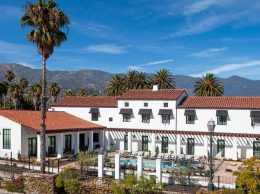New Santa Barbara chamber chief takes analytical approach
IN THIS ARTICLE
- Columns Topic
- Henry Dubroff Author
By Henry Dubroff Friday, June 7th, 2013

Ken Oplinger is an affable guy on a listening tour. He’s trying to engage in 100 conversations with influential people and organizations to gauge the state of play in business and economic vitality on the South Coast.
And as the first true outsider to run the Santa Barbara Region Chamber of Commerce in a couple of decades, that’s not a bad way to start. “I want to know: What kinds of things do people think about?” he told me in a recent conversation.
But that doesn’t mean Oplinger, 43, is a completely blank state. He already has figured out that business needs to have a stronger voice in civic affairs, but that there’s a delicate balance between growth and environmental issues.
And as a homeowner moving from a low-cost housing market to one of the priciest in the nation, he’s got an up-close and personal feel for the ongoing challenges in home affordability.
“At first glance, the Santa Barbara area looks prosperous and wealthy, but when you look at it more closely you can see some fraying around the edges,” he said.
Oplinger arrived in Santa Barbara on June 1 to take over from interim chief Zoe Taylor. I spoke with him on June 4 after lunch at the Chase Grill downtown.
A native of the Phoenix area, Oplinger spent 10 years as president of the chamber in the Bellingham/Whatcom area of Washington. He’s also no stranger to local politics; he was elected to city council in Blaine, Wash. after serving on the planning commission for six years.
“Chambers of Commerce can be political organizations, but they shouldn’t be partisan organizations,” he said. He also thinks local governments should be responsive to business in areas such as planning and permitting but that it’s not a good idea to try to pick winners.
So far, Oplinger said he’s picked up on the fact that the greater Santa Barbara area’s economic recovery has been built on a rebounding tourism industry and consumer spending. That’s good for balancing the city’s budget in the short term, but it means there are plenty of people who are underemployed or working two jobs. And there is still plenty of deferred maintenance that need a catch up.
With local governments facing huge pension costs in the future, Oplinger thinks there could be a natural alliance between public employees and business when it comes to economic vitality. That is a formula that’s been successful so far in Ventura County, where pension reforms combined with a more responsive attitude toward economic vitality has brought the county budget into balance.
And it has worked in San Luis Obispo County, where economic vitality has earned a place at the public policy table and been incorporated into the county’s general planning document.
This new consensus is built on the idea that improving the overall economy will increase tax revenue and, when combined with reforms to cap payouts and prevent spiking, can provide relief on the pension front.
Oplinger thinks that given the South Coast’s growth constraints, improving transportation links, between the South Coast and both North Santa Barbara County and Ventura County could help address housing affordability. Oplinger is particularly intrigued by the prospect of using smaller but higher frequency trains running on existing tracks to re-connect the region.
Twenty-something years ago Santa Barbara confronted the problems of a flagging central business district and failing infrastructure. A new chamber chief named Steve Cushman helped forge a consensus that built Paseo Nuevo and pushed improvements to Highway 101.
The 21st century presents similar problems but also more complex solutions. With his 100 conversations approach, Ken Oplinger is making a good start.
• Contact Editor Henry Dubroff at [email protected].












